Why do rivers never flow in a straight line but like to twist?
Certainly, there is no river system in the world flowing in a straight line, of course, not to mention artificial rivers and lakes. If you suspect this, you can verify it with Google's Google Earth application. But why, the river does not choose a straight line, the shortest road that keeps winding continuously stretches for thousands of kilometers like that?
- "Blood waterfall" in Antarctica, mysterious for hundreds of years has been decoded
- Humans are not the only species with fingerprints
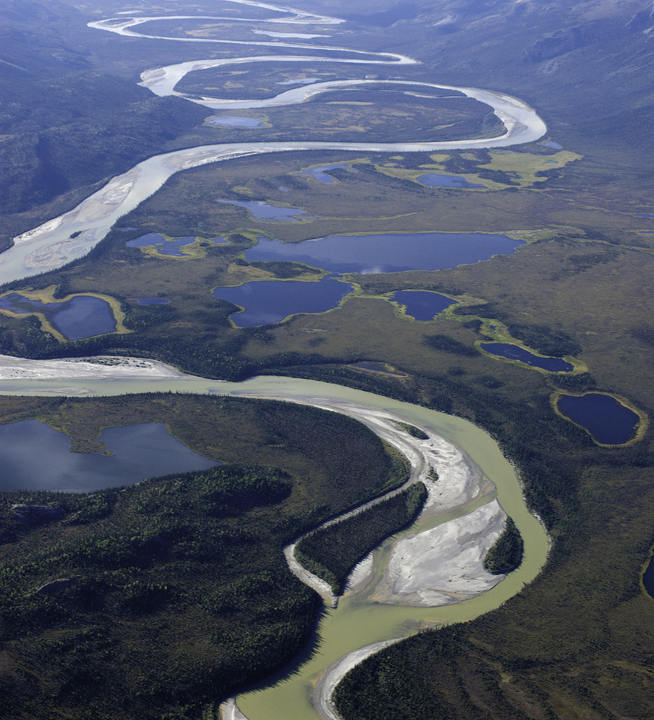
A river system in Alaska.
In fact, no river flows in a straight line, but they have to go through a long time to meander like that.
The cause of the phenomenon is that all rivers are winding from a combination of many elements in nature.
The following example will help us better visualize one of the reasons why rivers always bend without straightening.
An otter family appeared and "gouged out" one side of the river to make a nest. It was just a small hole, but that was enough to make the soil on the river bank weaker.
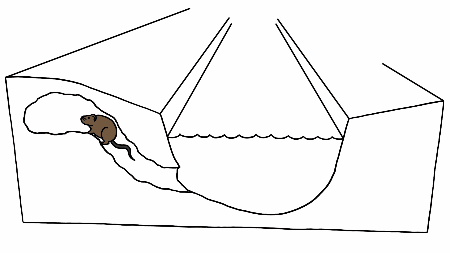
The water will flow into the hole with faster and faster speed due to the erosion of the soil layer, and at the same time weaken the flow of water on the remaining shore. The water carries sandy soil, accreting the remaining shore. For a long time, the straight river section will be turned into a curve.
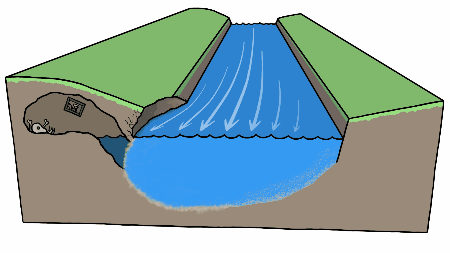
In fact, there are many elements of nature that are enough to make a section of the river straight into curvature, not a single digger otter. When a section of the river has been bent, it means that the direction of the flow of water has also changed direction, a force is created that impacts the soil on the river bank, causing the erosion to increase, and then the rest is gradually curved. according to an indispensable rule.
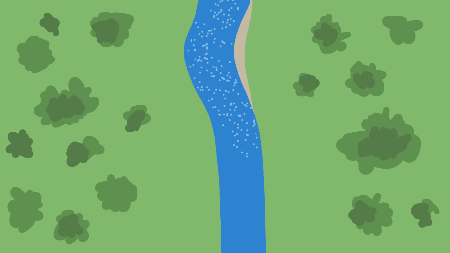
The truth is that the river flow is proportional to the length between the bends, the greater the flow, the longer the length. In particular, the length between an S-shaped bend will be 6 times the width of two river banks, meaning that a short river section will be like the miniature version of a larger river section.
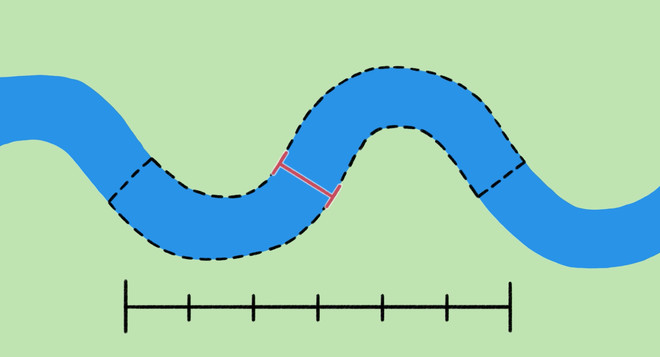
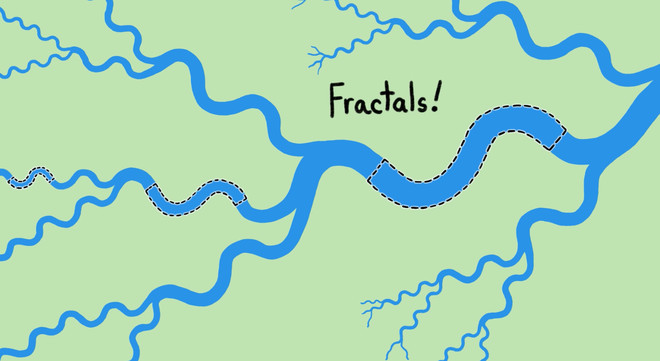
The river section will be bent continuously over time. If you do not encounter obstacles (such as boulders, mountains .) then at some time the two winding sections of the river will touch each other to form a lake, of the type of horseshoe (West Lake in Hanoi is a example of horseshoe type). After that, the river will flow straight again and the process of straightening into curvature literally continues.
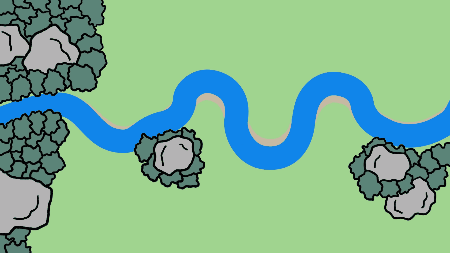
The origin of the horseshoe pool.
You should read it
- Top 10 longest rivers in the world today
- Decipher the mysterious success of the mysterious blue aquamarine river with 1-0-2 in the world
- How to play Rules Of Survival when the ball is narrowed into the sea, rivers and lakes
- Ways to survive underwater in Minecraft 1.19
- Listed 10 most picturesque but dangerous waterways in the world
- The most beautiful lakes of death in the world
- 6 ideal natural tourist lakes in Florida
- Prehistoric boats were excavated in India
May be interested
- Samsung Flow can be used on Windows 10 computers
 interested users have also heard that samsung is updating the samsung flow application so everyone can use it on windows 10 pc.
interested users have also heard that samsung is updating the samsung flow application so everyone can use it on windows 10 pc. - How to Go Straight to Desktop When You Sign in on Windows 8
 windows 8 is different from previous versions in that you start in a new start screen instead of going straight to the desktop after turning your computer on. you can change this and set your computer to go straight to desktop (just like...
windows 8 is different from previous versions in that you start in a new start screen instead of going straight to the desktop after turning your computer on. you can change this and set your computer to go straight to desktop (just like... - Some tricks or LINE users should know
 line is one of the most popular and used messaging and calling applications. according to statistics in april 2014, the number of subscribers using line amounted to more than 400 million, a number many customers dream about.
line is one of the most popular and used messaging and calling applications. according to statistics in april 2014, the number of subscribers using line amounted to more than 400 million, a number many customers dream about. - How to draw flow charts in Excel
 in this article, readers will learn how to set up a flowchart environment and create an excellent flow diagram in excel. some links for readers to download free microsoft excel flow charts will be placed at the end of the article.
in this article, readers will learn how to set up a flowchart environment and create an excellent flow diagram in excel. some links for readers to download free microsoft excel flow charts will be placed at the end of the article. - The most beautiful but dangerous rivers in the world
 not all rivers are safe and peaceful, sometimes they are so violent that they can deprive all people of what they have given.
not all rivers are safe and peaceful, sometimes they are so violent that they can deprive all people of what they have given. - Detect mysterious 10,000 ° C hot plasma penetrating Earth's atmosphere
 finding the mysterious plasma hot line of 10,000 ° c penetrating into the earth's atmosphere caused scientists to ask: is the earth's magnetic field weakened, causing solar winds to enter the atmosphere? ?
finding the mysterious plasma hot line of 10,000 ° c penetrating into the earth's atmosphere caused scientists to ask: is the earth's magnetic field weakened, causing solar winds to enter the atmosphere? ? - Decipher the mysterious success of the mysterious blue aquamarine river with 1-0-2 in the world
 only a 14-kilometer stretch of the río celeste is blue, then it is as transparent as other rivers.
only a 14-kilometer stretch of the río celeste is blue, then it is as transparent as other rivers. - The trick for Windows 8 to boot straight into the desktop
 besides cutting off start menu, when starting, windows 8 will display the metro screen instead of showing the desktop screen as the previous versions also cause many annoyances to users. therefore, we will guide you how to catch windows 8 straight to the desktop every time you start.
besides cutting off start menu, when starting, windows 8 will display the metro screen instead of showing the desktop screen as the previous versions also cause many annoyances to users. therefore, we will guide you how to catch windows 8 straight to the desktop every time you start. - Control flow in C ++
 flow control structures require the programmer to determine one or more conditions to be evaluated and checked by the program, along with the commands to be executed if the condition is determined to be correct, or other commands are done if the specified condition is wrong.
flow control structures require the programmer to determine one or more conditions to be evaluated and checked by the program, along with the commands to be executed if the condition is determined to be correct, or other commands are done if the specified condition is wrong. - These are the 13 weirdest skyscrapers in the world
 who says high-rise buildings must be straight, but twist is the trend today. let's contemplate the beauty of 13 skyscrapers with the weirdest twisted design in the world
who says high-rise buildings must be straight, but twist is the trend today. let's contemplate the beauty of 13 skyscrapers with the weirdest twisted design in the world










 20 animals are so strange that you don't believe they exist on Earth (part 1)
20 animals are so strange that you don't believe they exist on Earth (part 1) Shivered by the snail 6,000 teeth that eat deep in the earth like monsters in the movie
Shivered by the snail 6,000 teeth that eat deep in the earth like monsters in the movie Giant pythons devoured goats and were caught
Giant pythons devoured goats and were caught Strangely, fish can live on land for five years without dying
Strangely, fish can live on land for five years without dying Why do humpback whales prevent killer whales from hunting other animals?
Why do humpback whales prevent killer whales from hunting other animals? Find the 8th natural wonder of the world
Find the 8th natural wonder of the world